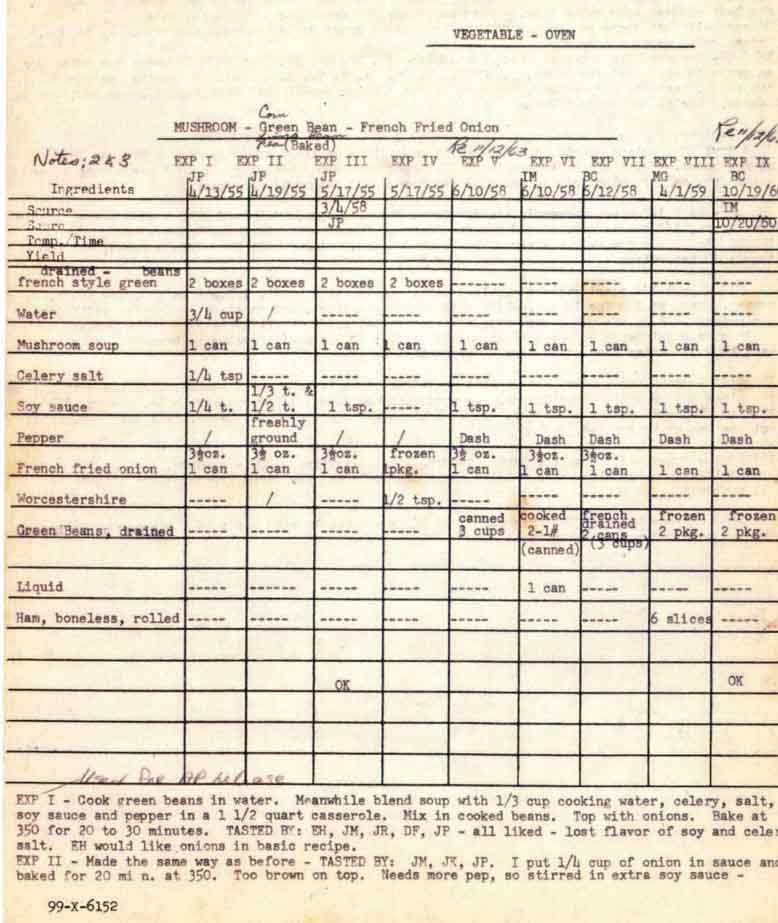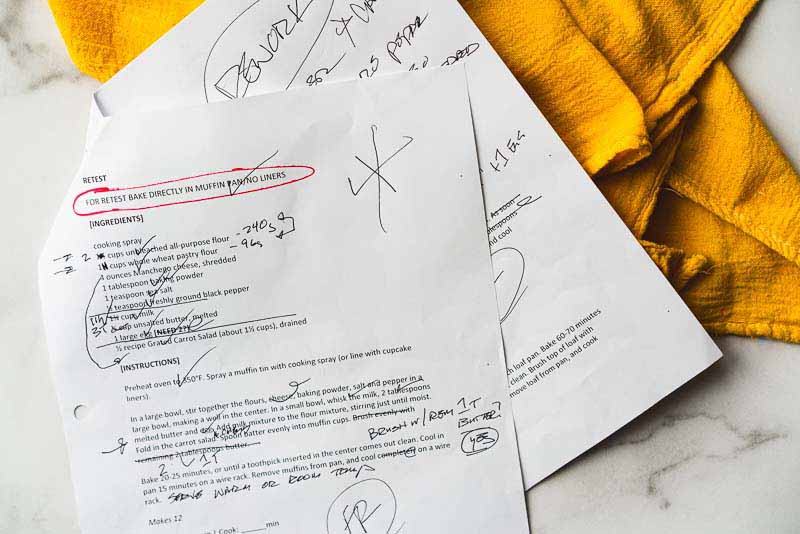Professional recipe development is a distinct process that ensures a specific, consistent, and delicious outcome. Here’s how it’s done right.
Green Bean Casserole is one of the most successful branded recipe development stories of all time.
It was created by Campbell Soup Co. test kitchen employee Dorcas Reilly in 1955 to promote the company’s cream of mushroom soup. It calls for just a handful of ingredients, minimal time, and virtually no skill to prepare.
In other words, it’s perfect.
Although Reilly developed the side dish in 1955, it didn’t become a Thanksgiving staple until 1960, when Campbell’s added the recipe to the soup can label. To this day, millions of Americans can’t imagine Thanksgiving without it. The recipe racks up 4 million views every year on Campbell’s site.
Reilly’s creation is so iconic that the original recipe and testing notes reside at the National Inventors Hall of Fame. It’s a fascinating document, noting nine tests over five years, with detailed typewritten and handwritten notes:

Recipe development testing notes for the iconic Campbell’s Green Bean Casserole.
The Art of Recipe Development
If the Green Bean Casserole testing notes look like a science experiment, that’s because it is. After all, cooking is chemistry. (Lessons in Chemistry was a best-selling novel and hit TV series about exactly that.)
But recipe development is also an art, and there are important steps before heading into the kitchen. These are some factors a professional recipe developer will consider up front:
Why develop this recipe? Is it to highlight a brand’s product, seasonal ingredient, or great technique? Or maybe the goal is to tap into a popular food trend. Often, it’s a combination of factors. But you want to know the top motivation and keep that in mind while developing the recipe.
When I created recipes for Palm Done Right, an industry initiative that promotes sustainably produced red palm oil, they wanted dishes to highlight their member brands’ products. If the recipes were vegan and/or gluten-free, even better.
A Hatch Chile Makes Great Content Strategy >>
Who’s the audience? Whether a recipe is for a brand or a publication, you also want to know what their audience likes to eat and how they like to cook. Do they want short ingredient lists, simple techniques, and minimal cleanup? Or are they adventuresome cooks up for the challenge of a new ingredient or technique?
When I develop recipes for Nourish Evolution’s Cook the Seasons menu planner, I know users are looking for dishes that make it easy to incorporate seasonal produce for healthy meals. They also like uncomplicated preparations, big flavors, and healthy spins on comfort food classics—dishes that will win over picky family members.
Another audience-focused example is King Arthur Baking, a brand that knows its customers extremely well. Its recipes support the company’s goal of selling flour, mixes, kitchen tools, and bakeware by delivering content that shares deep knowledge and builds trust to become a go-to resource.
Where will the recipe appear? On a product label, like the Green Bean Casserole? Then tight space will dictate a short ingredient list, simple instructions, and a broadly appealing dish that can be made by just about anyone.
Will it be published on a food site or in a magazine whose readers enjoy using new ingredients and relish a culinary challenge? They won’t mind a longer ingredient list, trendy ingredients, and a more involved method.
What does it need to look like? These days, it’s a given that a recipe will need to be camera-ready, as it’s going to be photographed or videoed (often both!) to catch viewers’ attention. I think about what it’ll look like from the beginning, whether I’ll be the one styling and shooting it or someone else will.
How to Pick a Winning Cover Recipe>>

Baked goods often require a series of tweaks and tests as part of the recipe development process.
The Recipe Testing Process
I first encountered recipe development and testing when working as a senior food editor at Cooking Light magazine. The process there was similar to Reilly’s at Campbell’s.
We’d send a recipe to the Test Kitchen, where a chef was assigned to test it. Then, we’d all gather around a table to taste it. The chef made notes in different-colored ink, depending how many tests had been done. Then the recipe was passed, scheduled for retesting, or killed.
Some days, we ate a lot of great food. Most days were a mixed bag, and others served up a buffet of duds.
It was all worthwhile because testing is a key step in the recipe development process, ensuring that what looks good on the page is great on the plate. It’s not always. And sometimes recipes that seem wonky on the page turn out fantastic. You just can’t know until you start cooking.
Testing is a key step in the recipe development process, ensuring that what looks good on the page is great on the plate.
Here’s what I’m testing with a recipe:
Does every ingredient contribute to the final dish? Do I need to add anything? Can I omit anything? I also note specific measurements and weights along the way.
Is every step in the instructions clear and necessary? Can I streamline things, even down to minimizing the number of pots and pans needed? I often cite Ina Garten as an ace recipe developer. Even in her most involved dishes, every ingredient pulls its weight, and every step maximizes flavor.
Are there any ingredients or steps that might confuse a reader? This depends on the audience, as well. But if something trips me up in testing, it’s sure to be a problem for readers.
Do I need to retest it? Adam Law, the Australian cookbook author, TV personality, and MasterChef Australia winner, doesn’t think more is always better. “The more times I need to test a recipe,” he notes, “the worse that recipe is.”
There’s some truth to this. If you’re testing a recipe repeatedly and it’s improving with each version, keep going! But if the dish doesn’t gel, no matter how many tweaks you make, it’s time to revisit the concept and redevelop the recipe from scratch.
Sometimes, you retest and tweak a recipe because ingredients and techniques evolve over the years. You can see this in the Green Bean Casserole testing notes. Early tests call for canned green beans before settling on frozen in 1960.
Today, Campbell’s recipe is much the same, though it now calls for milk instead of water for the liquid and “4 cups cooked cut green beans,” leaving it up to the reader to use use fresh, canned, or frozen green beans as they prefer.
Writing the Recipe
Once you’ve got a dish that works, it’s time to write a recipe that someone else can follow to achieve the same outcome consistently. After all, recipes have always been a form of viral content, requested from cooks and passed along, often for generations.
Here, too, what to include—and what to leave out —depends on who will be reading it. Or, as is so often the case now, watching it.
If you read a recipe written by your grandmother or great-grandmother, it’s likely short and sweet. That’s because she could assume a certain level of cooking skill and knowledge on the part of the person receiving it.
Today, even humble recipes can reach a much wider audience, thanks to blogs and social media. So it pays to be as specific as you can. I include as much detail as space allows—everything from measurements, weights, and package sizes in the ingredients to sight, scent, and taste cues in the instructions.
I know many folks diss blog recipes, especially overlong, SEO-driven posts padded with text and repetitive photos. But I’d argue that the Internet, free from the space constraints of print media, has been a boon for sharing details about ingredients and techniques that boost a reader’s chance of success.
At least, when it’s done well. This post about how to make Cantonese Steamed Fish from the popular Leung family blog Woks of Life (and now a cookbook!) is a mini masterclass packed with great info, from how to set up my wok for steaming to which fish to use.
I can’t wait to make it! And that’s what a well-written recipe does: whets the reader’s appetite and gives them the confidence to succeed.
Behind the Dish: When Flour Tortillas Stand In for Pancakes >>
